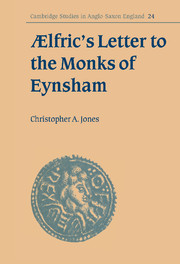Book contents
- Frontmatter
- Contents
- Acknowledgements
- List of abbreviations
- 1 The Eynsham ‘letter’ and the study of Ælfric
- 2 Structure and sources
- 3 The manuscript
- 4 Critical and editorial history
- Editorial principles
- Ælfric's Letter to the Monks of Eynsham: text and translation
- Commentary
- Appendix
- Bibliography
- Index of liturgical formae
- General index
4 - Critical and editorial history
Published online by Cambridge University Press: 06 October 2009
- Frontmatter
- Contents
- Acknowledgements
- List of abbreviations
- 1 The Eynsham ‘letter’ and the study of Ælfric
- 2 Structure and sources
- 3 The manuscript
- 4 Critical and editorial history
- Editorial principles
- Ælfric's Letter to the Monks of Eynsham: text and translation
- Commentary
- Appendix
- Bibliography
- Index of liturgical formae
- General index
Summary
The LME has won notice chiefly as an ancillary witness to the Regularis concordia, of which it is usually assumed to be a straightforward abridgement, and as a fixed point of reference in discussions of Ælfric's identity or the chronology of his career. Otherwise, the text has drawn little attention and has, through a remarkable series of accidents and misunderstandings, often been confused in secondary literature with the Regularis concordia or any of the Latin or Old English reflexes thereof. Lucia Kornexl's survey of the editorial history of the Concordia has laid bare centuries of confusion surrounding that text; only a brief word remains to be said about the implications of this peculiar history for the modern reception of the LME. The earliest reference to Ælfric's text occurs on the verso of a parchment flyleaf bound at the beginning of CCCC 265 itself. There a thirteenth-century hand has added a brief table of contents, of which the fifth item is, ‘Epistola Alfrici de consuetudine monachorum’. It is doubtful that this brief title alone accounts for the centuries-long tradition of calling Ælfric's customary a ‘letter’, but noteworthy that the inclination antedates modern scholarship.
In the sixteenth century the LME caught the attention of Matthew Parker's Latin secretary, John Joscelyn (1529–1603). Joscelyn's annotations occur in portions of CCCC 265, and he may be responsible for a few marginal notes added to the opening pages of the LME.
- Type
- Chapter
- Information
- Ælfric's Letter to the Monks of Eynsham , pp. 92 - 102Publisher: Cambridge University PressPrint publication year: 1999



